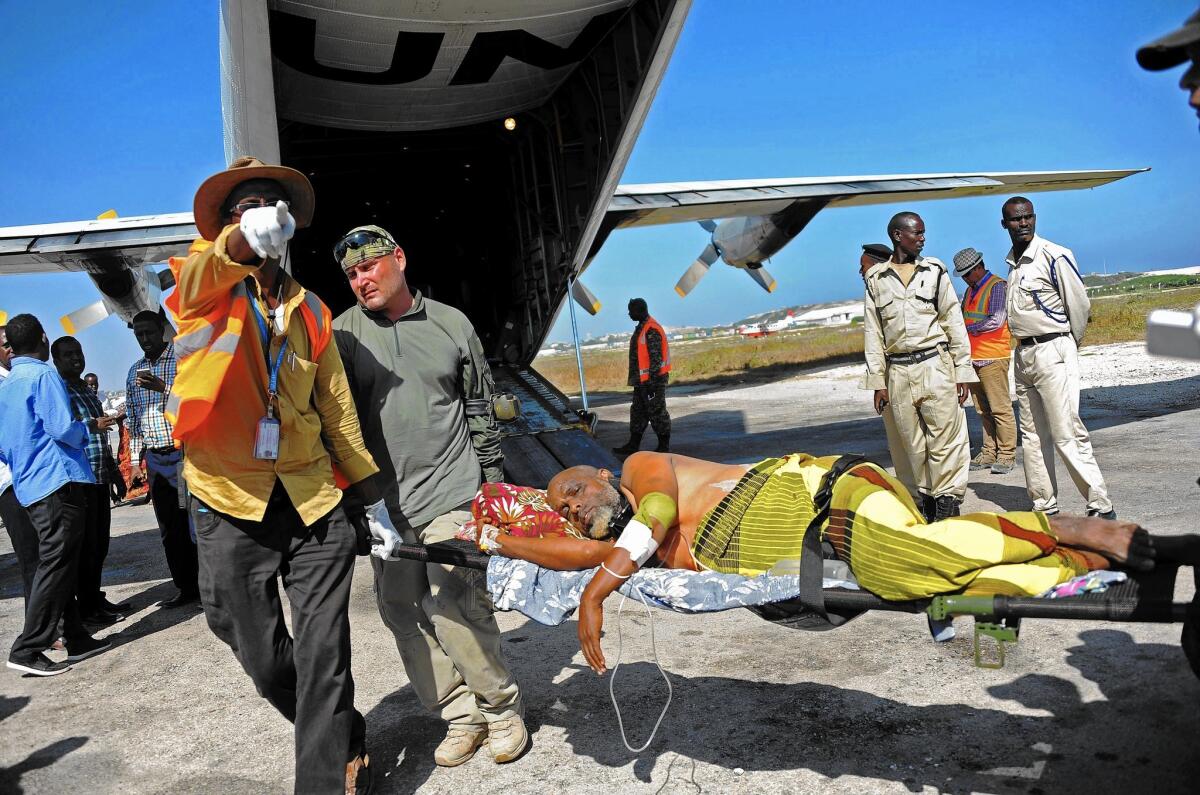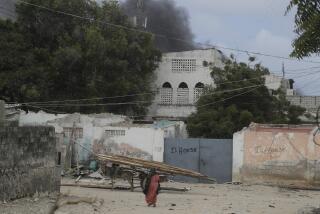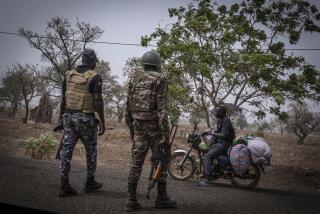Somalia militant group Shabab keeps bouncing back from attacks

reporting from JOHANNESBURG, South Africa — As U.S. forces scramble to confront militant groups across Africa, the Shabab, the Somali terrorist group targeted in a weekend attack north of Mogadishu, remains a nimble, formidable threat to American interests and allies in East Africa despite successive operations designed to crush it.
The operation Saturday by U.S. planes and Reaper drones hit the Shabab’s main operations center 120 miles north of the Somali capital and killed at least 150 fighters, dwarfing previous U.S. attacks on Somali militants and signaling a toughening U.S. response.
It also illustrated the resilience of groups such as the Al Qaeda-affiliated Shabab, which has lost a series of leaders and commanders to U.S. airstrikes yet still manages to launch devastating attacks in Somalia and neighboring Kenya.
U.S. airstrikes, operations in Somalia by American special forces and a 22,000-strong African Union force in Somalia, AMISOM, are all designed to stabilize the nation and protect its weak government.
The Shabab’s response has been to constantly switch tactics and targets, attacking airplanes, beach restaurants, hotels and African military bases in Somalia and briefly taking over a key port, all in the last few months.
Governments in West and East Africa have struggled to contain increasingly sophisticated and well-armed terrorist networks, raising fears about the potential threat such groups pose to Western targets in Africa and even beyond the continent.
The Shabab last year threatened to carry out attacks on a Minnesota mall, as well as targets in Britain and Canada.
The Pentagon sees Africa as a burgeoning front in the global war on terrorism with extremist groups Islamic State, Al Qaeda, Boko Haram and the Shabab controlling territory and launching attacks from various quadrants of the continent. The U.S. has responded by building up forces along Europe’s southern flank and within Africa.
Although there have been fears that these groups may expand cooperation and even plan joint attacks, rivalries among them have so far prevented that. Boko Haram has sworn allegiance to Islamic State, while others have remained loyal to Al Qaeda — but that has sparked new concerns that the rivalry could create an increase in attacks and one-upmanship.
Gen. David M. Rodriguez, head of the U.S. Africa Command, told the Senate Armed Services Committee on Tuesday that the U.S had significantly increased its posture in Africa over the last year, but despite attacks that had weakened the Shabab, the group continued to pose a danger.
“Shabab remains a continuing threat to U.S. persons and Western interests, and is conducting almost daily lethal asymmetric attacks in Somalia against AMISOM troops,” Rodriguez said, warning that the group could expand throughout East Africa.
He said many areas in Somalia were outside the control of the government, “providing Al Shabab with territory in which it can evade security forces and continue targeting East African regional governments and security interests as well as European and American interests.”
Two deadly terrorist attacks on hotels often used by Westerners in West Africa in recent months have driven home the growing threat to Western interests posed by African terrorist groups. Thirty people died in a January attack on a hotel and restaurant in Ouagadougou, Burkina Faso’s capital, carried out by Al Qaeda in the Islamic Maghreb and Al Mourabitoun. In November, Al Mourabitoun killed 20 people in an attack on the Radisson Blu Hotel in the Malian capital, Bamako.
Terrorist attacks in November by Islamic State militants in Paris, and the wave of migration into Europe from Libya and northern Africa, have put a spotlight on the possibility that other groups could infiltrate Europe to stage similar attacks.
Despite the loss of leader Ahmed Abdi Godane in a U.S. drone strike in 2014, and factional infighting over whether to align with Islamic State, the Shabab has been able to deal a series of recent devastating military blows, leaving African forces in Somalia badly rattled.
The Shabab inflicted one of Kenya’s biggest military losses in January, killing about 180 soldiers in an attack on a base in El-Adde, southern Somalia. Months earlier it launched a similar attack on a Burundian base in Leego that killed 54 soldiers. In September, 19 Ugandan soldiers were killed when the Shabab attacked their base in Janaale. In a sign of the Shabab’s recent strength, the group last month briefly took control of a key port, Merca, in southern Somalia.
The Shabab on Tuesday confirmed the U.S. attack but downplayed the casualties, insisting it never gathered large groups of fighters together because of the risk of drone attacks.
“We never gather 100 fighters in one spot for security reasons. We know the sky is full of planes,” Shabab spokesman Sheik Abdiasis Abu Musab said, according to Reuters.
The group, like the more deadly Nigerian terrorist group, Boko Haram, has been almost wiped out several times, only to reemerge with more deadly attacks and increasingly sophisticated tactics.
Last month, the Shabab managed to smuggle a laptop bomb through security at Mogadishu airport, blowing a hole in a Daallo Airlines jet, but killing only the suicide bomber. It is also believed to be responsible for a laptop bomb that exploded at a smaller Somali airport in Beledweyne on Monday. Two other bombs in electronic devices were found and defused at the same time, according to Somali officials.
The strikes on the Shabab camp followed several weeks of surveillance and followed intelligence that the group was planning attacks on African and U.S. forces, according to the Pentagon.
J. Peter Pham, director of the Atlantic Council’s Africa Center, said Saturday’s attack was the largest by U.S. forces in Africa since the 2011 airstrikes against the forces of former Libyan leader Moammar Kadafi. In terms of casualties, it was the deadliest attack on Somali militants, dwarfing previous operations by American forces since Sept. 11, he said, adding that all previous attacks on Somali extremists since then were estimated to have killed about 150 people.
“With the exception of airstrikes carried out against Kadafi forces in 2011 and recently against Daesh [Islamic State] in Libya, this is the biggest operation of the sort by U.S. warplanes in Africa since 9/11,” Pham said.
“Certainly in terms of militants taken out, it’s probably safe to say that more were eliminated this past weekend than in all confirmed U.S. operations [aerial and special operations forces] in Somalia since 2001,” Pham said.
Although the attack appeared to be a major setback for the Shabab, Pham said it was unlikely to cripple the group, which would continue its attacks on the weak Somali government, AMISOM and Western targets.
Before the rise of Islamic State, the Shabab recruited dozens of Americans to fight in Somalia. Pham said there was a risk that extremists could find their way back to the U.S., like the Islamic State militants who carried out the November attacks in Paris, killing 130 people.
He said the strike indicated the Shabab’s endurance, showing that it remained a serious strategic challenge for the United States.
“While the strike was tactically and operationally successful, that the militants were bold enough to assemble in such a manner is itself worrisome,” Pham said.
“The good news is that someone in the United States was keeping an eye on the ball. We had good enough intelligence that the group had assembled, and we were able to react quickly and eliminate the terrorists,” Pham said. “The bad news is that the group could assemble 150 people in one spot and was not afraid to do so. These are not signs of a group that is supposedly on the run or defeated.”
The Shabab grew out of the Islamic Courts Union, which drove warlords from Mogadishu in 2006. AMISOM forces expelled the Shabab from Mogadishu in heavy fighting in 2011 and in recent years have taken control of all the major towns and ports.
The Shabab has also carried out deadly attacks in Kenya and Uganda in reprisal for their participation in AMISOM, including an attack on a university in Garissa, northern Kenya, in April that killed 148 people, many of them Christian students. The group was responsible for the 2013 attack on a Nairobi shopping mall that left 67 dead.
Terrorist groups in Africa have been able to access weapons easily, notably after a flood of arms from Libya into neighboring countries following the collapse of the Kadafi government. The Australian navy announced Monday that it had seized an illegal cargo of weapons including 2,000 AK-47s, 100 rocket-propelled grenades and other weapons, concealed on a fishing boat bound for Somalia.
The U.S. officially recognizes just one base in Africa: Camp Lemonnier in Djibouti, which is led by the U.S. Navy and supports about 4,000 troops. There are also several unrecognized smaller installations in places such as Ethiopia and Kenya where U.S. drones, spy planes and special operations forces have been based.
In addition, the U.S. has thousands of troops stationed at Moron air base in southern Spain and at Sigonella air base in Sicily with the sole mission of being ready to deploy to North Africa at a moment’s notice.
Rodriguez said American operations helped African governments protect their populations, but ultimately helped protect Europe and America. He said unemployment and poor governance in some African countries created openings for violent extremists to expand.
“Relatively small but wise investments in African security institutions today offer disproportionate benefits to Africa, Europe and the United States in the future,” he said, “creating mutual opportunities and reducing the risks of destabilization, radicalization and persistent conflict.”
Times staff writer W.J. Hennigan in Washington contributed to this report.
Follow @RobynDixon_LAT for news from Africa.
More to Read
Sign up for Essential California
The most important California stories and recommendations in your inbox every morning.
You may occasionally receive promotional content from the Los Angeles Times.









